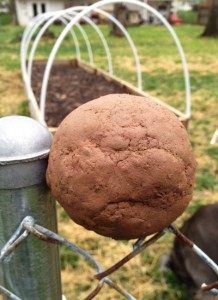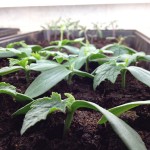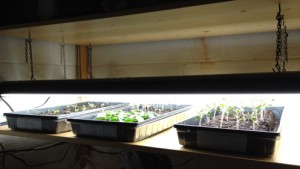
A clay baseball made from the soil in our yard. This ball actually stayed together well enough to throw it and have the dog fetch it and bring it back with only teeth marks to show for the adventure!
Have you ever wondered if the soil in you area has a lot of clay? I have read online about several tests you can perform to figure out what is in your soil. Though I have tried them (my favorite involves a mason jar and a scoop of soil), I have settled on the simplest of all: moisten some of your soil well, or just wait until a day after it rains. Dig up a scoop and try to make a ball out of it. If you can make yours look like the one in the picture on the left, congratulations – you have some serious clay content in your soil!
So, you have clay soil. What now? Some of the problems with high clay content are that it is so dense and heavy that water, plant roots and even your shovel have a hard time getting through it. Once water has managed to permeate the clay, it takes a long time to seep away. As a result, plants grown in clay tend to suffer from drowning, suffocating and rot more often than in loamy soils.
There are some benefits to clay soils, though. The nutrient levels in clay are quite high. Depending on where you live and what kind of clay you have, you will find that the PH of the soil is naturally beneficial a certain segment of plants. Here in the Washington D.C. region, our red clay is particularly acidic which is nice for plants such as hydrangea and blueberries. That said, you will need to improve the drainage and friability of you clay.
Ways to Improve You Clay Soil:
- Add Compost: If you practice composting, this is an excellent addition to the soil. Compost ‘lighten’ the clay, improving the drainage quality and availability organic matter and air for your plants. I have found that all of the compost I could possibly produce would not be enough to help all of the soil we garden. I have found a good source of vegetable compost (versus compost derived from sewage) and buy it by the cubic yard, which is a small pickup truck full. It costs about $30 per yard at Virginia Ground Covers. We have had good results in about a half and half mixture of compost to clay along with the other additions yet to be mentioned.
- Add Peat Moss: Peat Moss improves both the clay’s water retention and drainage qualities as well as further ‘lightening’ the soil so that plant roots can successfully penetrate the soil in search of nutrients. I mix in two 3-cubic-foot bales of peat into each cubic yard of compost in amending our clay. Peat is running about $10 per bale at Home Improvement stores.
- Add Coarse Builder’s Sand: Coarse sand will further improve the drainage of clay soils. We have only added sand to our blackberry and raspberry patches, finding that the volume of peat and compost is enough to work well in our other gardens. Coarse builder’s sand is readily available and inexpensive at your local Home Improvement store.
- Add Gypsum: Gypsum is sold by many different brand names for the purpose of ‘breaking’ your hardened clay soils, creating an environment more suitable for roots to grow and spread. The results of adding gypsum are due to a chemical reaction with the clay and are temporary. We have found it useful to add gypsum to new garden beds when we fist mix in our other amendments. The ‘breaking’ effects help to crumble the clay into smaller bits and integrate more thoroughly.
- Adjust your PH: You will need to test your soil in order to adjust your PH properly. I recommend having your local Extension Office complete the test versus buying a test kit at the store. The Extension Office performs a much more controlled test and achieves very accurate results. You will also need to know what types of plants you will be growing in order to adjust your PH to the correct level. I grew up cleaning out the fireplace ashes and tossing them around the Lilac bushes to ‘sweeten’ the soil, as my father calls it.
With the need for so many additions to our soil, we build raised beds for our gardening. With some guides to gardening, it is suggested that in raising the beds you might as well simply fill them with good garden soil and leave the existing clay alone. I am very careful to turn up the clay and mix it in to the amendments. Why? My wife asked me the same thing. There are several reasons:
Our native clay have mineral resources and nutrients that I would otherwise have to add, creating more effort and expenditure. Clay itself is has excellent water retention properties which are a welcome addition to any garden, in moderation. Working the amendments into the clay results in raised beds that are cultivated 6 to 8 inches below ground level, so our 12 inch tall raised beds are actually 18 to 20 inches deep in terms of perfect plant growing soil. Lastly, our clay represents here. Were I to grow my vegetables in the same purchased soil mixture as someone a thousand miles away, I might as well have grown them anywhere. I am attached to tasting a sense of Terroir in our food. There is more to Local Food than where it is produced. A producer of hydroponic lettuces just down the street is definitely local in that the produce has not been trucked a thousand miles (which I am thankful for), yet that same lettuce has no sense of place in the respect that it could have been grow anywhere. I’ll still buy the locally produced hydroponic lettuce over the heads grown half way around the world, and I’ll feel good about it! And I will still expend the extra effort required to churn our clay up into the compost of our raised beds.
Please share your adventures in working with clay soil. We’ve all taken different approaches and have differing results in trying to grow a successful garden in the hard-packed clay. Feel free to ask for some help, too! I’m sure that if I cannot help, there are many readers who have struggled with similar issues and would love to help.
Cheers!
~The Suburban Hayseed.


